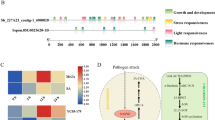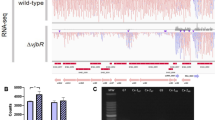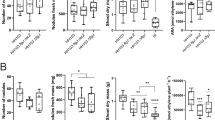Abstract
We reported previously that a 3.6-kb double-stranded RNA, designated as M2, is associated with hypovirulence in the Rhizoctonia solani isolate Rhs 1A1 and proposed that the M2-encoded putative polypeptide A (pA) might interfere with the regulation of the quinate and shikimate pathways. In this study, Western blot analysis showed that a protein band of the predicted size (83 kDa) binds antibodies specific to a pA epitope and is detectable in M2-containing but not in M2-lacking cultures. A mRNA, associated with Rhs 1A1 polysomes immunoprecipitated with anti-pA antibodies, has a sequence basically identical to that of the sense-strand of M2. The normally inducible quinate pathway was constitutively expressed, whereas the shikimate pathway was down-regulated in the M2-containing, hypovirulent Rhs 1A1. Finally, the relative concentration of phenylalanine, precursor of the virulence determinant phenylacetic acid, was correlated with the degree of pathogenicity in the virulent Rhs 1AP but not in the hypovirulent Rhs 1A1.


Similar content being viewed by others
References
Bentley R (1990) The shikimate pathway a metabolic tree with many branches. Crit Rev Biochem Mol Biol 25:307–384
Boosalis MG (1950) Studies on the parasitism of Rhizoctonia solani Kühn on soybeans. Phytopathology 40:820
Bradford MM (1976) A rapid and sensitive method for the quantitation of microgram quantities of protein utilizing the principle of protein–dye binding. Anal Biochem 72:248–254
Carling DE (1996) Grouping in Rhizoctonia solani by hyphal anastomosis reaction. In: Sneh B, Jabaji-Hare S, Neate S, Dijst G (eds) Rhizoctonia species: taxonomy, molecular biology, ecology, pathology and disease control. Kluwer, Dordrecht, pp 37–47
Chaleff RS (1974) The inducible quinate–shikimate catabolic pathway in Neurospora crassa: induction and regulation of enzyme synthesis. J Gen Microbiol 81:357–372
Chamberlain VK, Wain RL (1971) Studies on plant growth-regulating substances—the influence of ring substituents on the plant growth-regulating activity of phenylacetic acid. Ann Appl Biol 69:65–72
Coggins JR, Boocock MR, Chaudhuri S, Lambert JM, Lumsden J, Nimmo GA, Smith DDS (1987) The arom multifunctional enzyme from Neurospora crassa. Methods Enzymol 142:325–341
Davis RH (1975) Compartmentalization and regulation of fungal metabolism: genetic approaches. Annu Rev Genet 9:39–65
Davis RH, deSerres FJ (1970) Genetic and microbiological research techniques for Neurospora crassa. Methods Enzymol 17a:79–143
Forster G, Bernt E, Bergmyer HU (1974) Kreatine kinase. In: Bergmyer HU, Gawehn K (eds) Methods of enzymatic analysis. Academic Press, New York, pp 784–797
Frank JA, Francis SK (1976) The effect of a Rhizoctonia solani phytotoxin on potatoes. Can J Botany 54:2536–2540
Giles NH, Partridge CWH, Ahmed SE, Case ME (1967) The occurrence of the dehydroquinases in Neurospora crassa, one constitutive and one inducible. Proc Natl Acad Sci USA 58:1930–1937
Giles NH, Case ME, Baum J, Geever R, Huiet L, Patel VB, Tyler B (1985) Gene organization and regulation, in the qa (quinic acid) gene cluster of Neurospora crassa. Microbiol Rev 49:338–358
Giles NH, Geever RF, Asch DK, Avalos J, Case ME (1991) Organization and regulation of the qa (quinic acid) genes in Neurospora crassa and other fungi. J Hered 82:1–7
Grant S, Roberts CF, Lamb HK, Stout M, Hawkins AR (1988) Genetic regulation of the quinic acid utilization (qut) gene cluster in Aspergillus nidulans. J Gen Microbiol 134:347–358
Hawkins AR, Giles NH Kinghorn JR (1982) Genetical and biochemical aspects of quinate breakdown in the filamentous fungus Aspergillus nidulans. Biochem Genet 20:271–286
Hawkins AR, Da Silva Francisco SJ, Robert CF (1984) Evidence for two control genes regulating expression of the quinic acid utilization (QUT) gene cluster in Aspergillus nidulans. J Gen Microbiol 130:567–574
Hawkins AR, Lamb HK, Moore JD, Charles IJ, Roberts CF (1993a) The prechorismate (shikimate) and quinate pathways in filamentous fungi: theoretical and practical aspects. J Gen Microbiol 139:2891–2899
Hawkins AR, Moore JD, Lamb HK (1993b) The molecular biology of the pentafunctional AROM protein. Biochem Soc Trans 21:181–186
Huiet L (1984) Molecular analysis of the Neurospora qa-1 regulatory region indicates that two interacting genes control qa gene expression. Proc Natl Acad Sci USA 81:1174–1178
Jian J, Lakshman DK, Tavantzis SM (1997) Association of distinct double-stranded RNAs with enhanced or diminished virulence in Rhizoctonia solani infecting potato. Mol Plant-Microbe Interact 10:1002–1009
Lakshman DK, Tavantzis SM (1994) Spontaneous appearance of genetically distinct double-stranded RNA elements in Rhizoctonia solani. Phytopathology 84:633–639
Lakshman DK, Jian J, Tavantzis SM (1998) A novel mitochondrial double-stranded RNA found in a hypovirulent strain of Rhizoctonia solani occurs in DNA form, and is phylogenetically related to the pentafunctional AROM protein of the shikimate pathway. Proc Natl Acad Sci USA 95:6425–6429
Lamb HK, Hombergh JPTW van der, Newton GH, Moore JD, Roberts CF, Hawkins AR (1992) Differential flux through the quinate and shikimate pathways: implications for the channeling hypothesis. Biochem J 284:181–187
Lamb HK, Newton GH, Levett LJ, Cairns E, Roberts CF, Hawkins AR (1996) The QUTA activator and QUTR repressor proteins of Aspergillus nidulans interact to regulate transcription of the quinate utilization pathway genes. Microbiology 142:1477–1490
Levesley L, Newton GH, Lamb HK, Schothorst E van, Dalgleish RWM, Samson ACR, Roberts CF, Hawkins AR (1996) Domain structure and function within the QUTA protein of Aspergillus nidulans: implications for the control of transcription. Microbiology 142:87–98
Lin JK, Chang JY (1975) Chromophoric labeling of amino acids with 4-dimethylaminoazobenzene-4'-sulfonyl chloride. Anal Chemistry 47:1634–1637
Liu C (2001) Quinic acid-mediated induction of hypovirulence and a hypovirulence-associated double-stranded RNA in Rhizoctonia solani. PhD thesis, University of Maine, Orono
Norman JA, Montgomery MK (2001) RNAi and cosuppression: double stranded RNA as an agent of sequence-specific genetic silencing in animals and plants. In: Tavantzis SM (ed) DsRNA genetic elements: concepts and applications in agriculture, forestry, and medicine. CRC Press, Boca Raton, pp 1–36
Nuss DL, Koltin Y (1990) Significance of dsRNA elements in plant pathogenic fungi. Annu Rev Phytopathol 28:37–58
Ogoshi A (1996) The genus Rhizoctonia. In: Sneh B, Jabaji-Hare S, Neate S, Dijst G (eds) Rhizoctonia species: taxonomy, molecular biology, ecology, pathology and disease control. Kluwer, Dordrecht, pp 1–10
Orellana RG, Mandava NB (1983) m-Hydroxyphenylacetic and m-methoxyphenylacetic acids of Rhizoctonia solani: their effect on specific root-nodule activity and histopathology in soybean. Phytopathol Z 107:159–167
Orser CS, Beck C (1990) Immunological techniques for molecular plant pathology: polysome immunopurification. In: Hampton R, Ball E, De Boer S (eds) Serological methods for detection and identification of viral and bacterial plant pathogens. APS Press, St Paul, pp 359–364
Sambrook J, Fritsch EF, Maniatis T (1989) Molecular cloning: a laboratory manual, 2nd edn. Cold Spring Harbor Laboratory Press, Cold Spring Harbor, N.Y.
Sherwood RT, Lindberg CG (1962) Production of a phytotoxin by Rhizoctonia solani. Phytopathology 52:586–587
Simpson RJ, Neuberger MR, Liu TY (1976) Complete amino acid analysis of proteins from a single hydrolysate. J Biol Chem 251:1936–1940
Stocchi V, Piccoli G, Magnani M, Palma F, Biagiarelli B, Cucchiarini L (1989) Reverse-phase high-performance liquid chromatography separation of dimethylaminoazobene sulfonyl- and dimethylaminoazobenzene thiohydantoin-amino acid derivatives for amino acid analysis and microsequencing studies at the picomole level. Anal Biochem 178:107–117
Tavantzis SM (ed) (2001) DsRNA genetic elements: concepts and applications in agriculture, forestry and medicine. CRC Press, Boca Raton
Tavantzis SM, Lakshman DK (1995) Virus-like double-stranded RNA elements and hypovirulence in phytopathogenic fungi. In: Kohmoto K, Singh RP, Singh US (eds) Pathogenesis and host–parasite specificity in plant disease: histopathological, biochemical, genetic and molecular basis, vol 3. Elsevier, Oxford, pp 249–267
Tavantzis SM, Perkins BL, Bushway RJ, Bandy BP (1989) Correlation between in vitro synthesis of phenylacetic acid and virulence in Rhizoctonia solani. Phytopathology 79:1199
Tavantzis SM, Lakshman DK, Liu C (2001) Quinate induction of dsRNA and hypovirulence in Rhizoctonia solani. Phytopathology 91 [Suppl]:S150
Wyllie TD (1962) Effect of metabolic by-products of Rhizoctonia solani on the roots of chippewa soybean seedlings. Phytopathology 52:202–206
Acknowledgements
We thank Dr. Paul Winnard, currently at Johns Hopkins University for suggestions regarding the quinate dehydrogenase and shikimate kinase assays, and Dr. Eric Floreto for help on the amino acid HPLC analysis. This is Maine Agriculture Forestry Experiment Station publication 2612.
Author information
Authors and Affiliations
Corresponding author
Additional information
Communicated by U. Kück
Rights and permissions
About this article
Cite this article
Liu, C., Lakshman, D.K. & Tavantzis, S.M. Expression of a hypovirulence-causing double-stranded RNA is associated with up-regulation of quinic acid pathway and down-regulation of shikimic acid pathway in Rhizoctonia solani . Curr Genet 42, 284–291 (2003). https://doi.org/10.1007/s00294-002-0348-1
Received:
Revised:
Accepted:
Published:
Issue Date:
DOI: https://doi.org/10.1007/s00294-002-0348-1




